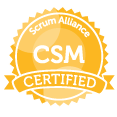 From a business standpoint, one of the most vital roles on any Scrum team is the Product Owner (PO). It is a challenging role, one that requires the PO to take accountability for making business decisions about the product–decisions such as which features to include and the priority of those features. However, these decisions cannot be made in a vacuum. Because the PO must get input from other business stakeholders, they need skills such as facilitation, conflict management, creative thinking, and the ability to influence the team and other stakeholders. If such a role appeals to you, then you are ready to become a Certified Scrum Product Owner.
From a business standpoint, one of the most vital roles on any Scrum team is the Product Owner (PO). It is a challenging role, one that requires the PO to take accountability for making business decisions about the product–decisions such as which features to include and the priority of those features. However, these decisions cannot be made in a vacuum. Because the PO must get input from other business stakeholders, they need skills such as facilitation, conflict management, creative thinking, and the ability to influence the team and other stakeholders. If such a role appeals to you, then you are ready to become a Certified Scrum Product Owner.
Although Product Owner is often considered the most difficult role in Scrum, becoming a Certified Scrum Product Owner (CSPO) is relatively easy. Here’s everything you need to know.
What is a Certified Scrum Product Owner?
As a CSPO, you will be prepared to take on the role of Product Owner on a Scrum team. The Product Owner is a key stakeholder who is responsible for ensuring that each product feature provides maximum value in a timely manner. How the Product Owner accomplishes this can vary widely depending on many factors, including the team, the business stakeholders, and the development processes of the organization. A Product Owner’s typical responsibilities include:
- Developing and executing the Product Vision.
- Writing or participating in the writing of product features. These features are really product requirements, usually written in the form of user stories.
- Developing and prioritizing the list of these features called a product backlog. The PO needs to make sure all team members know the priorities and work toward the common goal.
- Reviewing, testing, and accepting the product.
- Requesting changes.
- Writing and reprioritizing the user stories as changes are identified.
Because some of the responsibilities and competencies of the PO role are similar to business analysis, many organizations employ business analysts in the role of a product owner. There are a number of issue with this approach, but they are beyond the scope of this blog.
What are the requirements to become a CSPO?
Before becoming a Certified Scrum Product Owner, you must first familiarize yourself with Scrum. The best way to do this is by reading the Agile Manifesto and Scrum Guide and watching the Scrum Foundations eLearning Series.
Once you have completed these prerequisites, you must attend an in-person CSPO course taught by a Certified Scrum Trainer (CST). Most courses begin with a short quiz that confirms you are familiar with the principles of Scrum and thus prepared to handle the challenges presented in the course.
RELATED BLOGS
What is the CSPO course?
The CSPO course is an in-person course that consists of two 8-hour days. In the course you will learn the fundamentals of Scrum and the responsibilities of the Product Owner through exercises, discussions, and case studies. The main topics of a CSPO course include:
- Techniques for developing a Product Vision
- How to create, maintain, and order a Product Backlog
- How to identify user needs
- An overview of sizing in Scrum
- How to manage stakeholders
Learning Objectives
Participants in a CSPO course should expect that each of the learning objectives identified in this blog will be covered in a CSPO course:
- Understanding the role of the product owner
- Describing purpose and strategy
- Understanding customers and users
- Testing product assumptions
- Working with the product backlog
What’s next after completing the course?
Unlike ScrumMaster certification, there is no test to become a Certified Scrum Product Owner. Once you have successfully completed the course, you are eligible to be a CSPO. You’ll also be able to display the CSPO logo and be eligible for 16 Scrum Education Units (SEUs) or 14 Professional Development Units (PDUs).
To develop your skills further, you can become an Advanced Certified Scrum Product Owner or a Certified Scrum Professional Product Owner.
Are you ready to become a Certified Scrum Product Owner?
If you’re ready to help your team and advance your career, then it’s time to become a Certified Scrum Product Owner. Register for your CSPO certification course today and put yourself—and your team—on a path to long-term success.
Have additional questions about the Certified Scrum Product Owner certification? Read Q&As from a recent CSPO course, or leave a comment below.

Elizabeth Larson, PMP, CBAP, CSM is a consultant and advisor for Watermark Learning/PMA. She has over 35 years of experience in project management and business analysis.
Elizabeth has co-authored four books and chapters published in five additional books, as well as articles that appear regularly in BA Times, Project Times, and Modern Analyst. Elizabeth was a lead author/expert reviewer on all editions of the BABOK® Guide, as well as the several of the PMI standards.
Elizabeth also enjoys giving presentations, and her speaking history includes repeat keynotes and presentations for national and international conferences on five continents. Elizabeth enjoys traveling, hiking, reading, theater, and spending time with her 7 grandkids.


 New Horizons
New Horizons
 Project Management Academy
Project Management Academy
 Six Sigma Online
Six Sigma Online
 Velopi
Velopi
 Watermark Learning
Watermark Learning
 Login
Login




 New Horizons
New Horizons
 Project Management Academy
Project Management Academy
 Velopi
Velopi
 Six Sigma Online
Six Sigma Online
 Watermark Learning
Watermark Learning